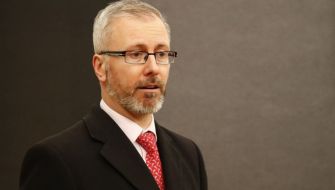A “substantial” number of people will be contacted in the coming months about how their data was compromised in the 2021 HSE cyber attack, a committee has heard.
The ransomware attack resulted in the HSE having to close down all of its IT services, causing widespread delays and the cancellation of appointments at hospitals across the country.
The HSE’s interim chief executive Stephen Mulvaney appeared before the Public Accounts Committee on Thursday for the first time since taking up the role after his predecessor Paul Reid stepped down on Monday.
He told the committee that he did not believe anyone affected by the cyber attack had been contacted yet, but said he expected that would begin “in the coming months”.
“There is a significant volume of work which is progressing so we can get to the point where we can appropriately communicate with those individuals who do need to be communicated with, and we are very anxious to do so in a way that does not cause unnecessary upset.
“We’ve been conscious that this is taking longer than people might expect, however the volume and complexity of what we’re dealing with is very, very substantial.”
'Substantial number'
HSE chief operations officer Damian McCallion, who also appeared before the committee, said there was “a substantial number of people that will need to be contacted”.
“We stood up a team who will be making contact for people so all of that part of it is in place in terms of contacting people.”
He said that work was ongoing to work out who needed to be contacted.
“I don’t want to throw out a number that isn’t correct to here today, we’re trying to finalise that, but it’s a substantial number of people that will need to be contacted.”
Mr Mulvaney also committed to ensuring that most pandemic bonuses would be paid to Section 38 and 39 workers, including Dublin Fire Brigade workers, by the end of the year.
“We understand that our colleagues and Section 39s need to get this recognition, we absolutely do. It’s simply a question of the practicalities of it and making those payments.”
Mr Mulvaney and Mr McCallion were among the HSE and Department of Health officials before the committee on Thursday to discuss expenditure on emergency services.
The committee was told that around 3,018 new staff will be needed by the National Ambulance Service by 2028 for the ambulance service to meet future demand.
Last year, 70 new recruits were hired by the National Ambulance Service (NAS).
Director of the National Ambulance Service Robert Morton agreed that greater improvement around recruitment was needed and that 90 student paramedics started in September, with further students to start in December.
“From a core ambulance perspective, we need 2,161 additional staff by 2028.
“That also includes a number of new service developments that will be focused on preventing many patients from needing to go to hospital. Particularly older, frail patients and we’re developing a lot of services to treat patients at home.
“In addition to the 2,161 growth, we also need to recruit 854 just to stand still – that’s to allow for retirements, resignations and internal movement.”
Paramedic training
Mr Morton said that paramedics are educated in Dublin, Ballinasloe and Tullamore, but over the next three years they are looking to expand into Wexford, Cork and Sligo “so that we can effectively double our education capacity to meet the future workforce needs”.
He also said that it was a “myth” that two ambulances are sent to a callout in case one breaks down.
“If we do send two vehicles it depends on the clinical criteria of the call.
“So, in the event of a cardiac arrest, for example, we send two resources as a matter of clinical requirement to make sure that there’s three to four practitioners or responders on the scene.
“We would never never send two vehicles because of a mechanical issue,” he said.
Clinical director of the NAS Professor Cathal O’Donnell said that ambulance response time targets are a “blunt instrument” in measuring an ambulance service, and “doesn’t really impact on patient outcomes”.
“A 90-minute response time over the breadth of the kinds of clinical presentations that we see and for many of them, it doesn’t really impact on patient outcomes.

“From a clinical perspective, we’re much more interested in how can we improve the patient’s acute healthcare.
“If we’re sending two very highly-trained clinicians on a call, and if they get there in 90 minutes or 20 minutes or 15 minutes if you’re having a heart attack or a stroke or you have a broken leg, that’s a very blunt instrument in terms of success.”
He said one of the indicators they have is in cases of cardiac arrests, what proportion of patients had their heart restarted before arriving at an emergency department. Two other indicators relate to stroke care and the fourth clinical key performance indicator is in relation to pain relief.







